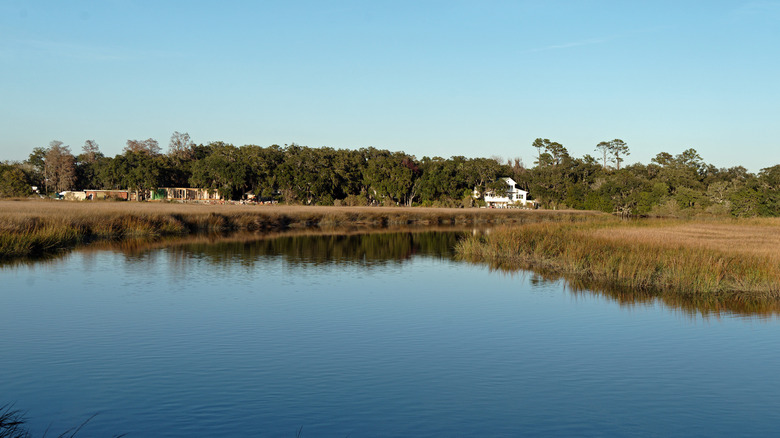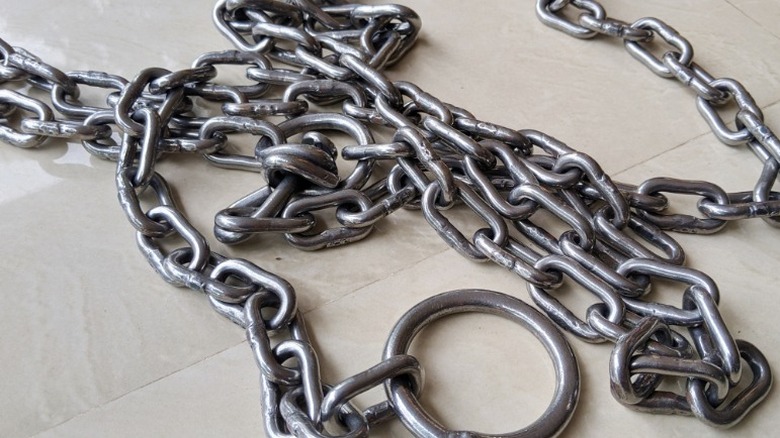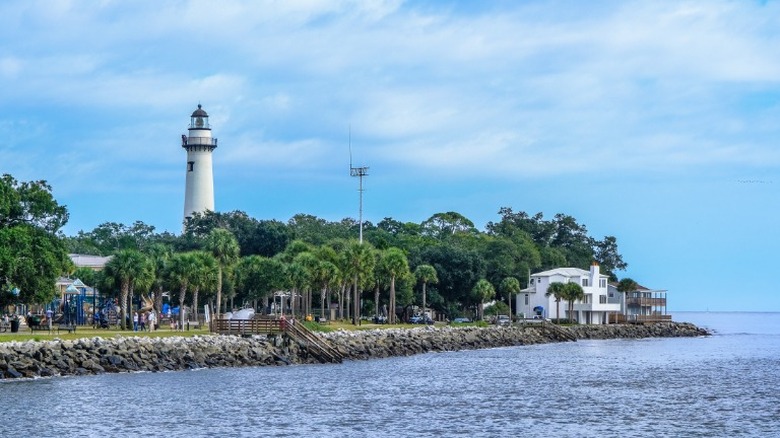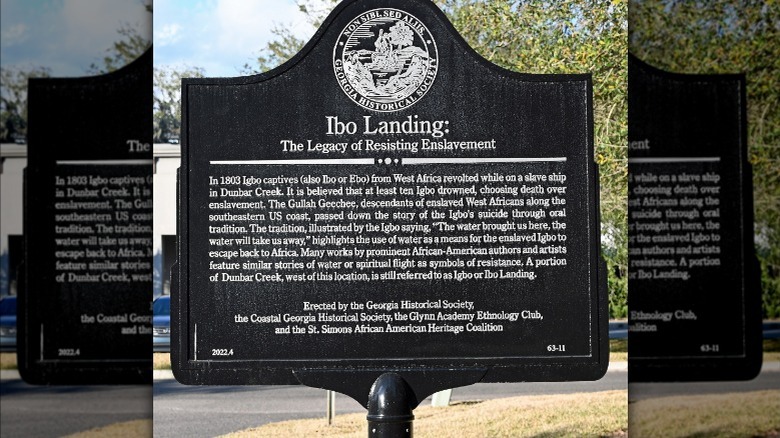The Harrowing Tale Of The Slave Rebellion At Igbo Landing
The trans-Atlantic slave trade is a part of Western civilization's history that has been difficult to come to terms with. The capture and enslavement of African peoples resulted in over 12 million lives shipped from their homes to auctions on the coasts of North America, South America, and various sites in the Caribbean (per PBS). Roughly 15 percent would die en route. PBS states that the Trans-Atlantic Slave Trade Database has compiled a thorough collection of data from that barbaric industry and reveals that from those millions that were forced to board the slave ships, less than 400,000 were sold on North American soil.
The trip from their homes to the faraway shores that awaited them was considerably harsh. According to the Library of Congress, the people were stripped of all their clothes and possessions and put into heavy chains. These human beings were treated like farm animals and stowed below deck, crammed next to each other on the long voyage. Deaths from malnutrition, disease, and suffocation were not uncommon. They were also at the mercy of the ship's crew, some of whom would torture and kill the people below deck on a whim.
One group of people from modern-day Nigeria lost an estimated 1.5 million of their population to the slave trade (per BBC). The Igbo (sometimes Ibo) began to populate the shores of North America, suffering in bondage. The plight that they knew lay ahead of them prompted one small band of Igbo to take matters into their own hands early in the 19th century.
Chained enslaved people rose in rebellion and seized control of the York
Just off the coast of southern Georgia lies St. Simons. This barrier island is home to beautiful beaches, world-class golf, and some of the most picturesque landscapes in the southeastern U.S. (per St. Simons Island). The many tourists who travel there for relaxation and daytime excursions might not be aware that the destination is home to one of the most notable rebellions of enslaved people in U.S. history.
The story began when the ship Wanderer unloaded its cargo of enslaved people in the port of Savannah, roughly 80 miles up the coast from St. Simons. Those who had been cramped in the bowels of the ship were from several regions in Western Africa, including many that were Igbo people (per Blackpast). A number of the people who were sold at auction that day were purchased by traders John Couper and Thomas Spalding. These two men paid $100 for each person, with the plan of reselling them to area plantations for a profit.
Couper and Spalding had these enslaved people taken to the York, a coastal ship. Clad in chains, these mostly Igbo enslaved people were put under the York's deck and sent on a journey to St. Simons. The voyage down the coast was a short one, but it didn't take long for the Igbo on board the ship to quickly hatch and execute a plan that would give them control of the York. An estimated 75 of the enslaved people rose up, killed the crew members on board, and seized control of the vessel.
A mass suicide followed
The crew members were captured and drowned (per Blackpast). But in all of the chaos, the York ran aground at Dunbar Creek on St. Simons. The sequence of events that followed is debated by historians, but what is known is that the leader of the Igbo led his people off the York and onto land. Said to be singing during their march, they most likely knew what fate awaited them. Their leader then had his people follow him into Dunbar Creek, where it's said that 75 drowned.
The uprising and mass suicide were first recorded by an overseer at an area plantation. Roswell King detailed how he and another man went into the water to recover the bodies, but only 13 were accounted for. It's not known if any of the Igbo survived the suicide attempt that day, but the minimal number of bodies found has made it difficult to determine just how many marched into the water that day.
The Igbo march into the sea that followed their uprising has been referred to by some as the first freedom march on U.S. soil. The dozens of people who decided to take control and choose their fate of death over a lifetime of human bondage have been the subject of local folklore since the event happened in 1803. Along with tales of Dunbar Creek being haunted by the weary souls who died that day, alternate versions of events have been passed down through the ages, giving promise that their self-sacrifice was for a greater purpose.
The tragedy led to wonderful folklore
The New Georgia Encyclopedia gives a much different narrative surrounding the fates of the brave souls who walked into the water that day. This source tells of how the story was passed down as an oral tradition for over 200 years in a folk tale better known as the "Myth of the Flying Africans." The Igbo story at the landing spawned legendary qualities that would also be told in children's stories, novels, and on the small screen.
According to the folklore, the Igbo were being whipped by the overseer one day and had finally had enough. They put their tools on the ground, gathered together, and began a transformation that would carry them home. The Igbo turned into buzzards and flew across the ocean back to where they were taken from.
The story told by members of the community was handed down for generations and grew to become a "powerful metaphor of African American courage, longing, and conviction." This treasured story is not the only one that has been handed down, however. There is another oral tradition that lends to a belief that is a bit more harrowing.
The Igbo's uprising has inspired works of literature
According to the New Georgia Encyclopedia, the "Myth of the Flying Africans" was used as the backdrop for the Toni Morrison novel "Song of Solomon." The novel follows its protagonist, an African American man named Milkman Dead, as he travels from his home in the northern United States to the deep south to learn about his familial history. Throughout his journey, he becomes familiar with folklore that ties his family to an African shaman whom he is supposed to have descended from. According to the legends he discovers on his way, the shaman could achieve flight. At the end of the book, Milkman Dead gains his ancestral powers and flies away home when he is near death.
Morrison's literary works eventually led her to win the 1993 Nobel Peace Prize in literature (per The New York Times). She was only the eighth woman to win the prestigious award and the first African American woman to do so. Among her other works are "Jazz" and "Beloved."
A monument was erected in 2022 to serve as a memorial to those who perished
Community members have long worked to make sure that the historical facts from the Igbo Landing rebellion have been forgotten. In 2002, the African American community in St. Simons organized a special event to commemorate the many facets of Igbo history. The two-day-long celebration featured a memorial processional to the site of the mass suicide. Blackpast tells of how the event brought in 75 attendees from multiple states in the U.S., as well as three foreign nations. The location has since been considered "holy ground." When the processional made their way there, the members said prayers and asked for the souls that were lost there to be at rest.
In May 2022, a historical marker was erected on St. Simons as a reminder of the site's past. Georgia Public Broadcasting reports that some members of the community were vocal about how this dedication was overdue. Sandy White, who serves as the education director for the Coastal Georgia Historical Society, stated, "This event seems like it would be an obvious choice for a marker, and yet it took until 2022 to get one. So many of the monuments and markers in this area were done in what we kind of think of as the heyday for memorials and markers. That [era] often wasn't very kind to the African American experience here, or largely ignored it."
The schools in Georgia are also doing their part. Igbo Landing is now part of the curriculum in coastal schools. This way, students can choose how to honor their sacrifice.





